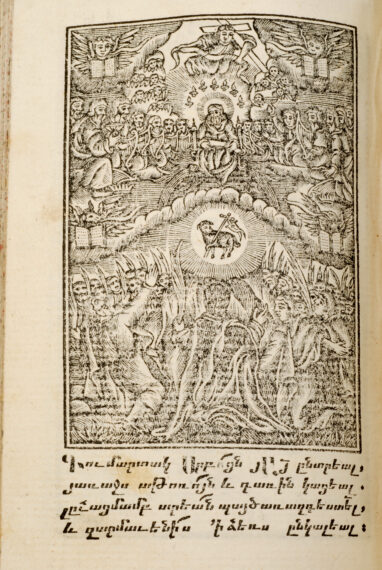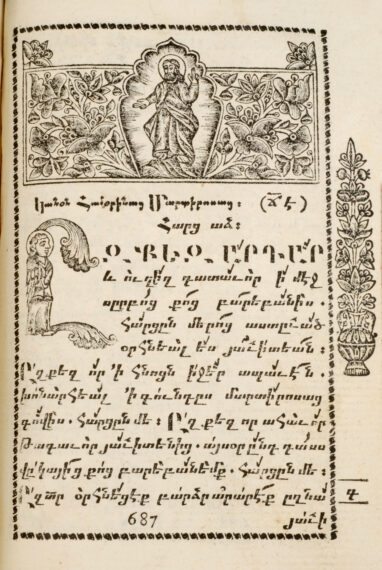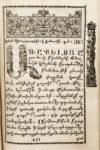HYMNAIRE, 1789
Printed, 1789. Etchmiadzine
HYMNAIRE, 1789
Printed, 1789. Etchmiadzine
On two registers, the throne of God surrounded by the chosen ones is represented at the top, in the four corners the symbols of the evangelists.
Below, the adoration of the mystic lamb and a choir of angels.
Western influence.
Owing to the sacred value attributed by the Armenian people to the handwritten book, the printed book did not supersede it until the 19th century, almost three hundred years after the first publication of a book which came off the press in Venice in 1511. In its early days the printed book was, unlike manuscripts, exclusively the work of the diaspora. It was in Europe that the first works were published, initially in Venice and later in Amsterdam, where the first Bible was printed in 1666. The texts published in the 16th and 17th centuries were sometimes of religious, sometimes historical, and sometimes scholarly nature.
In the 18th century, Venice underwent a revival thanks to the considerable work of Abbot Mekhitar of Sebaste. The typography workshop on the island of San Lorenzo, opposite Venice, published a number of classical Armenian works, as well as translations of European literary works for use by students, historical and philological studies, and the 1837 dictionary, which is still the authoritative reference today.
It was only in the 19th century, however, that printing really took off with the secularization of culture which, until then, had been disseminated under the quasi-monopoly of the Church.
The replacement of the classical language by modern Armenian and the development of the press completed this evolution.
This heralded the birth of modern literature.
The printed book is no longer just an edition of the manuscript.
It now became an instrument of modern thought.
The Charaknotz contains hymns for religious feasts, classified alphabetically or in musical order. It consists of tropes (the use of a word or expression in a figurative sense) inserted in the liturgical songs to explain the meaning of each feast day.
The Feast of Pentecost
This Christian feast commemorates the descent of the Holy Spirit on the Apostles on the fiftieth day after Easter. The word “Pentecost” derives from the ancient Greek ""pentekoste"" meaning fiftieth (day after Easter).
Originally, Pentecost was a Jewish holiday, like Passover. It recalls the historical event of the gift of the Torah at Sinai. Thus Shavu'ot (the Jewish Pentecost) is the conclusion and the closing of Pesah (the Jewish Passover). Indeed, it was for the purpose of giving it the Torah that God brought Israel out of Egypt: true freedom consists in accepting to follow the Law of God!
The Book of the Acts of the Apostles (2:1-13) record the event that took place in the Cenacle in Jerusalem, in the year 30 or 33 of our era, on the Jewish feast of Pentecost, 50 days after the resurrection of Christ. “When the Day of Pentecost had fully come, they were all with one accord in one place. And suddenly there came a sound from heaven, as of a rushing mighty wind, and it filled the whole house where they were sitting. Then there appeared to them divided tongues, as of fire, and one sat upon each of them. And they were all filled with the Holy Spirit and began to speak with other tongues.”
The Christian Pentecost is therefore the feast of the gift of the Holy Spirit.
The account in the Acts of the Apostles tells of ""a great noise"" coming from heaven, a ""violent gust of wind"" and ""tongues of fire"" that laid themselves on each of the apostles. The noise, the wind and the fire symbolise the presence of God; they are a manifestation of the divine power. It is the renewal of the theophany of Sinai which is commemorated by the Jewish Pentecost.
While fire symbolises divine presence, the tongues of fire that divide themselves over the heads of the apostles signify the descent of the Spirit of God upon them. They symbolise the gift given to each of them so they would have the capacity to proclaim, with a tongue of fire, the Gospel to all men.
Lastly, the account refers to the gift of tongues received by the apostles and disciples to enable them to proclaim the Good News of the Gospel to all men and all nations. We can see in this a response to the episode of the Tower of Babel. Indeed, at the time of the Tower of Babel, men were divided for their desire to be greater than God. At Pentecost, the divided peoples are united again upon the manifestation of the Holy Spirit.
The Pentecost celebrated by Christians celebrates the birth of the Church, this new people of God, of global dimension, which was formed when the risen Jesus ""received from the Father the promised Holy Spirit and poured it out"" (Acts of the Apostles 2: 33) on the group of his apostles and disciples who believed in Him and were assigned the mission of being his witnesses all over the world.







